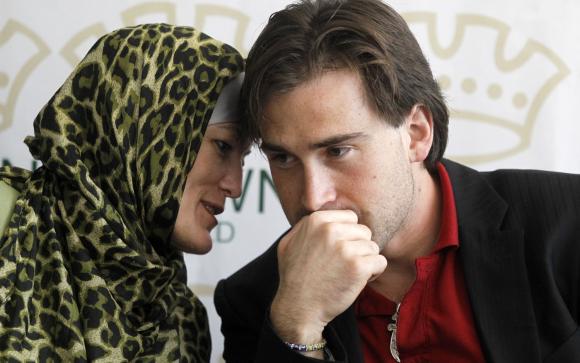Muslim Converts Biography
Source:- Google.com.pkOur Prophet Muhammad (pbuh) was the son of 'Abdullah bin 'Abdul-Muttalib bin Hashim bin 'Abd Manaf. His genealogy goes to 'Adnan in the 21st stage of his generation and 'Adnan is the descendent of Isma'il ( in the 40th stage. Isma'il (pbuh) was the eldest son of Ibrahim, the friend of Allah.
The Prophet (pbuh) was born at Makkah on the 9th Rabi-ul-Awwal. His father had died before he was born. His mother passed away, when he was six years old. Her name was Aminah. Her lineage merges with the Prophet's paternal side three generations earlier. When the Prophet (pbuh) was eight years two months and ten days old, his grandfather breathed his last. Abu Talib, who was his father's own brother, became his guardian.
In the thirteenth year of his life, he proceeded on a journey to Syria with his uncle but he came back from the onward journey. When he became an adult, he got engaged in trade for sometime.
When he was 25 years old, he married Khadijah. Then he devoted his time either in prayers to Allah or to the welfare of the people. In the same year a dispute arose over the construction of the Ka'bah. All men made him an arbitrator as he was considered truthful and trustworthy among the people of the place.
First Nine years of the Prophethood
When he was forty years and one day old, revelation dawned upon him that he was the Messenger of Allah. Khadijah (wife), Ali Murtuda, (cousin aged 10 years), Abu Bakr Siddiq (friend), and Zaid bin Harithah (his slave) soon accepted his Faith.
On the instructions of Abu Bakr Siddiq, Uthman Ghani, Abdur-Rahman bin 'Auf, Sa'd bin Abi Waqqas, Talhah and Zubair accepted Islam. Abu Ubaidah, Abu Salamah, Arqam, 'Uthman bin Maz'un, 'Abdullah bin Mas'ud, Ubaidah bin Al-Harith, Sa'id bin Zaid, Yasir, 'Ammar and Bilal embraced Islam after them. Among the women, Khadijah and Umm-ul-Fadl (the wife of Abbas) accepted Islam after the Prophet's daughters. Thereafter Asma' (Abu Bakr Siddiq's) daughter) and then Fatimah, (Umar Farooq's sister) entered into the fold of Islam.
For three years, the Prophet (pbuh) silently preached Islam. Then he openly began to propagate the teachings of his religion. He conveyed his messages to people wherever he saw them sitting or standing in groups. The inhabitants of Makkah then began to persecute the Muslims. They had a grievance that Muslims did not worship idols at all. The Muslims suffered the great ordeal for two years. Then being sick of them, they decided to migrate from Makkah.
Migration of the Muslims
In the fifth year of the declaration of prophethood, 'Uthman Ghani was the first person to leave his hearth and home for Habash (Ethiopia) with his wife Ruqaiyyah, the second daughter of the Prophet. The Prophet (pbuh) announced that 'Uthman was the first person to migrate for the cause of Allah after Prophet Lut (pbuh). Five women and twelve men also accompanied him till he reached the seacoast. Thereafter many Muslims followed him in the migration to Habash. Among them was also Ja'far Taiyyar who was the own brother of Ali Murtuda.
In the sixth year of prophethood, Hamzah (the Prophet's uncle) and three days later 'Umar Farooq embraced Islam.
Muslims used to say their prayers in hiding till then, but afterwards, they were openly praying in the Ka'bah.
In the seventh year of prophethood, the Quraish solemnly decided not to entertain any relationship or establish contacts with the Muslims. They also severed relations and contacts with the Hashimites as they could not keep themselves aloof from the Prophet (pbuh).
Sha'b Abi Talib
In view of the persecution and ill-treatment, the Prophet (pbuh) and the Hashimi tribe kept themselves into a valley, called 'Sha'b Abi Talib'. Enemies did not allow eatables to be taken into the place; children, being starved, wept piteously and their cries were heard in the town nearby. Some persons who were kind and compassionate would bring something secretly during night for them to eat. In spite of these difficult situations, the Prophet (pbuh) kept on preaching the principles of the true religion regularly.
10th year of Prophethood
The Prophet (pbuh) went to Ta'if to lecture on Islam. Whenever he stood to address, the people used to throw stones and injure him so badly that he would not be able to take out his shoes as blood would have clotted in them.
Once, he received so many assaults that he fell unconscious. Zaid bin Harithah who accompanied him, picked him away from the village. When he sprinkled water over his face, he came into sense. The Prophet (pbuh) left the place and declared that if these people did not accept Islam, their descendants would certainly embrace the religion. After eight years, all the people living in Ta'if reverted to Islam.
11th year of Prophethood
The Prophet (pbuh) preached the message of Islam to those who passed along the ways. One day, he heard the voices of people, while they were talking, he moved towards them. Six men from Al-Madinah were staying there. The Prophet (pbuh) delivered a lecture and taught them the principles of Islam and they accepted Islam.
12th year of Prophethood
When he was 51 years and 5 months old, he achieved Mi'raj (the Ascension) on the 27th day of Rajab. It was made compulsory for Muslims to observe their prayers five times a day. Earlier, the prayers of the morning and evening were observed.
During the Hajj season, 18 persons from Al-Madinah came to Makkah and they embraced Islam on the Prophet's instructions. He also sent Mus'ab bin 'Umair to Al-Madinah to preach the religion of Islam. In this holy area Islam spread rapidly. By the lectures of Mus'ab, the people belonging to Banu Najjar and Banu Ashhal tribes and other clans accepted Islam within a period of one year.
13th year of Prophethood
Two women and 71 men came from Al-Madinah and reverted to Islam and requested the Prophet (pbuh) to visit Al-Madinah. He agreed to go and stay at Al-Madinah. They also declared to remain firm on the path of Islam and to obey and support the Prophet (pbuh).
When the polytheists of Makkah came to know that Islam was spreading outside Makkah as well, they decided to assassinate the Prophet (pbuh). One night they surrounded the Prophet's house but he came out safely from the besieged house.
The Hijrah (Emigration) to Al-Madinah
Coming out of his house, the Prophet (pbuh) stayed three days and nights in the cave of Thaur. Abu Bakr Siddiq ( was also with him. They came out of the cave on the 1st Rabi-ul-Awwal of 1st AH on Monday. Two camels were ready for transport. On the first camel the Prophet (pbuh) and Siddiq rode, and on the second were 'Amir bin Fahirah - the slave of Abu Bakr Siddiq ( and a man conversant with the routes. And they moved towards Al-Madinah.
When the enemies came to know of the departure of the Prophet (pbuh), they announced big rewards for the one who could intercept him or cut off his head and bring it to them. Many people pursued him for the sake of reward but only two persons reached them. One was Malik bin Suraqah, who returned after begging pardon of him for his guilt, and the other was Buraidah Aslami with 70 riders who reverted to Islam soon after seeing his noble face and listening to the verses of the Qur'an, and the Prophet (pbuh) proceeded onward with them.
1st year of Hijrah
1. As soon as the Prophet (pbuh) reached Al-Madinah, he got a mosque constructed for prayers. The walls were made of mud and the roofs were laid with date leafy stalks.
2. Till then there were only two compulsory Rak'at (units of prayer) for the noon, afternoon and night prayers; but here onwards, four Rak'at were made compulsory for these three times prayers.
3. Agreements were reached with the Jews and the adjoining tribes for peace and friendliness.
4. Bonds of brotherhood developed between Muhajireen (the emigrant Muslims) of Makkah and those of Al-Madinah, called Ansar (helpers). The followers of the same religion loved the Makkans more than their brothers and permitted them to share in their properties on equal terms.
The Prophet (pbuh) proceeded towards Makkah for 'Umrah, but he was stopped to move forward by the Quraish, 14 miles away from Makkah. The Prophet (pbuh) halted there, and during his stay there, an agreement with the Quraish was reached on the following points:-
1. Peace be maintained for ten years, travel and transactions should be freely operated. Every tribe be allowed to join hands with the Muslims or the Quraish.
2. The Muslims were allowed to offer their prayers in the Ka'bah the following year.
3. If a person from the Quraish reverts to Islam and reaches the Prophet (pbuh), he or she be sent back to Quraish, but if a Muslim gives up Islam and goes to Quraish, he would not be sent back. On this point the Muslims were perturbed but the Prophet (pbuh) gladly accepted this condition as well.
The Quraish thought that no person would revert to Islam in view of this condition. But when the agreement was being drafted, Abu Jandal, son of Suhail (who came to negotiate for the agreement from the Makkans) reached there. He was already a Muslim but he was kept in confinement by the tribe. Getting an opportunity he had fled there. Iron chains were still in his feet.
Suhail demanded to hand over his son Abu Jandal according to the terms of the agreement.
The Muslims refused to act upon the terms of the agreement as it was not signed by them up till then. Suhail then got agitated and said that they would not enter into an agreement.
The Prophet (pbuh) handed over Abu Jandal to them. They then put him again into confinement. He then began to teach the basic principles of Islam in the jail and by this means 300 people embraced Islam within a year at Makkah itself. Everyone who has some sense can understand from this fact how the sincerity of the Prophet (pbuh) and the charms of his religion were captivating hearts that (difficulties like) separation from near and dear ones, distances from native land, fear of sufferings and rigorous imprisonment could not deter people from accepting Islam.
Delegations to the Emperors
In the year 6 AH, the Prophet (pbuh) sent delegates to important emperors of his time and appealed them to accept Islam. Their names are mentioned here:
1. The king of Habash (Ethiopia), Ashamah Najashi (Negus) accepted Islam under the impact of the letter written by the Prophet (pbuh).
2. The king of Bahrain named Mundhir reverted to Islam. His subjects in large numbers also followed suit.
3. Jaifer, the king of Oman, and his brother embraced Islam.
4. Khosro (Chosroes) was the king of Iran. He tore the letter of the Prophet (pbuh) and asked the ruler of Yemen to send him the Prophet (pbuh) as a captive. The ruler's name was Bazan. He gathered correct information about the Prophet (pbuh), and embraced Islam. His subjects also followed him.
5. The king of Alexandria was Muqawqas who did not accept Islam, but he sent costly gifts for the Prophet (pbuh).
6. The ruler of Syria was Harith who did not accept the religion of Islam.
7. Haudha was the ruler of Yamamah. He did not embrace Islam.
8. The king of Rome was Hirqil (Heraclius) who first of all gathered information about the Prophet (pbuh). Then he advised his courtiers to accept the faith of Islam but they did not agree to his proposal and were ready to revolt. So the ruler did not accept the Faith lest he should lose his throne. The king collected information about the Prophet (pbuh) by issuing orders to present before him anyone coming from Makkah to Syria. Abu Sufyan was found and was presented to the ruler along with some other men. Abu Sufyan had several skirmishes with the Prophet (pbuh) and he was his strong critic.
Abu Sufyan says that he was brought to the town of Elia. The court was full of important royal officers and Hirqil was sitting wearing his crown. He asked his interpreter to ask who was close in kinship to the man who was pronouncing as Prophet (pbuh).
Abu Sufyan: I am his kin.
Muslim Converts Islam Facts For Kids Pictures About Religion Wikipedia And History And Beliefs Worksheet On Women Today And Information Images Wallpapers

Muslim Converts Islam Facts For Kids Pictures About Religion Wikipedia And History And Beliefs Worksheet On Women Today And Information Images Wallpapers

Muslim Converts Islam Facts For Kids Pictures About Religion Wikipedia And History And Beliefs Worksheet On Women Today And Information Images Wallpapers

Muslim Converts Islam Facts For Kids Pictures About Religion Wikipedia And History And Beliefs Worksheet On Women Today And Information Images Wallpapers

Muslim Converts Islam Facts For Kids Pictures About Religion Wikipedia And History And Beliefs Worksheet On Women Today And Information Images Wallpapers

Muslim Converts Islam Facts For Kids Pictures About Religion Wikipedia And History And Beliefs Worksheet On Women Today And Information Images Wallpapers

Muslim Converts Islam Facts For Kids Pictures About Religion Wikipedia And History And Beliefs Worksheet On Women Today And Information Images Wallpapers

Muslim Converts Islam Facts For Kids Pictures About Religion Wikipedia And History And Beliefs Worksheet On Women Today And Information Images Wallpapers

Muslim Converts Islam Facts For Kids Pictures About Religion Wikipedia And History And Beliefs Worksheet On Women Today And Information Images Wallpapers

Muslim Converts Islam Facts For Kids Pictures About Religion Wikipedia And History And Beliefs Worksheet On Women Today And Information Images Wallpapers

Muslim Converts Islam Facts For Kids Pictures About Religion Wikipedia And History And Beliefs Worksheet On Women Today And Information Images Wallpapers

Muslim Converts Islam Facts For Kids Pictures About Religion Wikipedia And History And Beliefs Worksheet On Women Today And Information Images Wallpapers

Muslim Converts Islam Facts For Kids Pictures About Religion Wikipedia And History And Beliefs Worksheet On Women Today And Information Images Wallpapers

Muslim Converts Islam Facts For Kids Pictures About Religion Wikipedia And History And Beliefs Worksheet On Women Today And Information Images Wallpapers

Muslim Converts Islam Facts For Kids Pictures About Religion Wikipedia And History And Beliefs Worksheet On Women Today And Information Images Wallpapers

Muslim Converts Islam Facts For Kids Pictures About Religion Wikipedia And History And Beliefs Worksheet On Women Today And Information Images Wallpapers

No comments:
Post a Comment